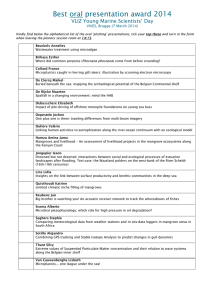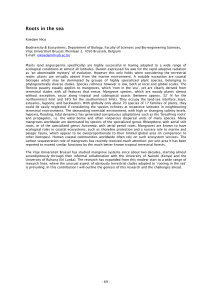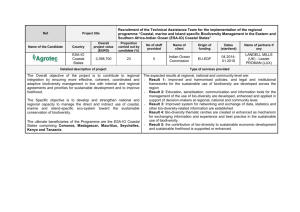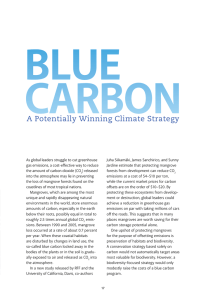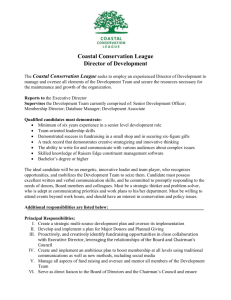Preserving Blue Carbon to Limit Global Climate Change A
advertisement
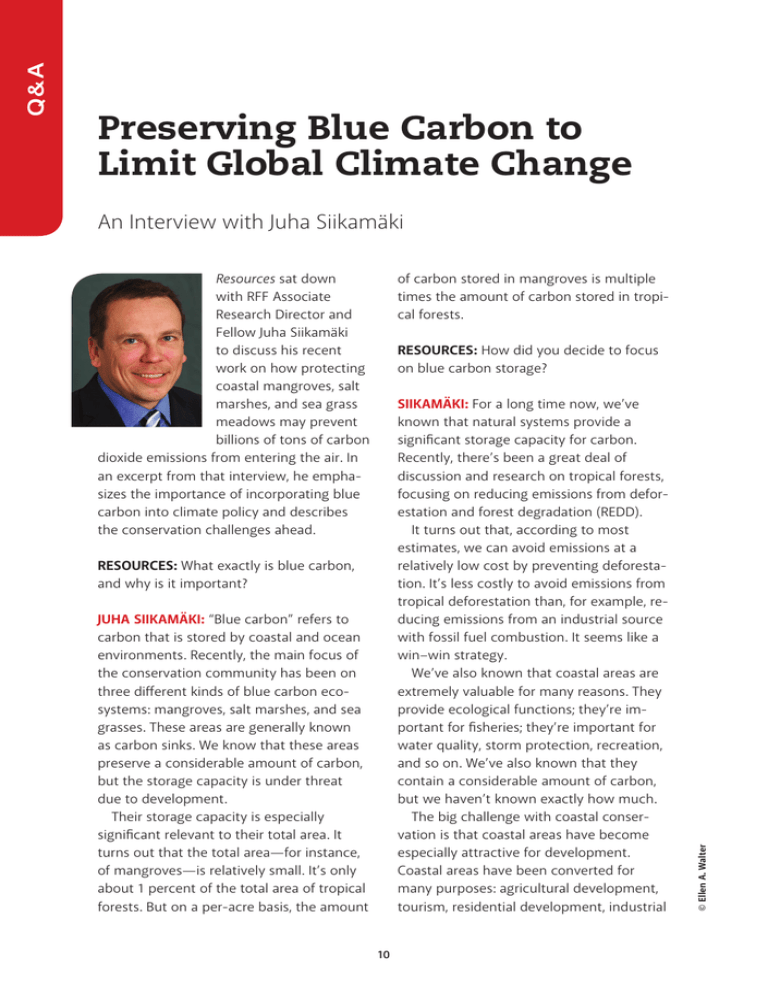
An Interview with Juha Siikamäki Resources sat down with RFF Associate Research Director and Fellow Juha Siikamäki to discuss his recent work on how protecting coastal mangroves, salt marshes, and sea grass meadows may prevent billions of tons of carbon dioxide emissions from entering the air. In an excerpt from that interview, he emphasizes the importance of incorporating blue carbon into climate policy and describes the conservation challenges ahead. of carbon stored in mangroves is multiple times the amount of carbon stored in tropical forests. RESOURCES: How did you decide to focus on blue carbon storage? SIIKAMÄKI: For a long time now, we’ve known that natural systems provide a significant storage capacity for carbon. Recently, there’s been a great deal of discussion and research on tropical forests, focusing on reducing emissions from deforestation and forest degradation (REDD). It turns out that, according to most estimates, we can avoid emissions at a relatively low cost by preventing deforestation. It’s less costly to avoid emissions from tropical deforestation than, for example, reducing emissions from an industrial source with fossil fuel combustion. It seems like a win–win strategy. We’ve also known that coastal areas are extremely valuable for many reasons. They provide ecological functions; they’re important for fisheries; they’re important for water quality, storm protection, recreation, and so on. We’ve also known that they contain a considerable amount of carbon, but we haven’t known exactly how much. The big challenge with coastal conservation is that coastal areas have become especially attractive for development. Coastal areas have been converted for many purposes: agricultural development, tourism, residential development, industrial RESOURCES: What exactly is blue carbon, and why is it important? JUHA SIIKAMÄKI: “Blue carbon” refers to carbon that is stored by coastal and ocean environments. Recently, the main focus of the conservation community has been on three different kinds of blue carbon ecosystems: mangroves, salt marshes, and sea grasses. These areas are generally known as carbon sinks. We know that these areas preserve a considerable amount of carbon, but the storage capacity is under threat due to development. Their storage capacity is especially significant relevant to their total area. It turns out that the total area—for instance, of mangroves—is relatively small. It’s only about 1 percent of the total area of tropical forests. But on a per-acre basis, the amount 10 © Ellen A. Walter Q& A Preserving Blue Carbon to Limit Global Climate Change ronments, however. In particular, most of the carbon in tropical forests is stored in the living trees and their roots. When we talk about coastal ecosystems, especially mangroves, the situation is very different. The biomass stores carbon, but most of the carbon is stored in the soil as a result of hundreds of years of accumulation and sequestration. From the REDD perspective, the difference is quite critical. Rules for other tropical forests do not allow accounting for soil carbon—so REDD effectively rules out mangroves. One of the key next steps to consider is to find ways of accounting robustly for the soil carbon in coastal environments. There has been a good bit of work in this area recently. In fact, there is a new voluntary carbon standard designed specifically for accounting for carbon in wetlands. RESOURCES: How do you determine how much carbon is stored by mangroves? SIIKAMÄKI: We started out from a satellitebased map of mangrove areas globally. Across the 140,000 square kilometers of mangroves that have been identified throughout the world, we divided those areas into small locations—roughly 5.5 by 5.5 miles in area. For each plot, we developed an estimate of mangrove biomass above and below ground. That gave us an estimate of the carbon stored in the biomass. Additionally, we developed estimates of the amount of soil carbon in mangroves. A lot of natural science goes into answering the question. RESOURCES: In some of your previous research, you noted that targeting forests for conservation purely based on carbon storage may lead to missed opportunities to save areas rich in plant and animal species. Can you explain how we can combine the goals of forest carbon sequestration and biodiversity preservation? SIIKAMÄKI: The basic dilemma here is that the areas that are most attractive for preserving carbon may not be the same areas that would be most attractive for preserving biodiversity. There’s some overlap, but these different goals can significantly impact the kinds of areas that we would target for conservation. In the context of mangroves, the difference is actually less critical. It turns out that even by focusing on carbon sequestration, we can preserve quite a bit of biodiversity. And the same is true if we focus on biodiversity preservation—the RESOURCES: How could blue carbon be incorporated into REDD programs? SIIKAMÄKI: In principle, the same general framework would work, especially for mangroves. Mangroves are forests. So in that sense there would be a natural fit under the REDD umbrella. A few important differences exist between tropical forests and coastal envi- 11 Q& A development, and even fisheries development. And coastal development can create very high returns. The idea is that maybe blue carbon will help strengthen the case for coastal preservation. Missing from this debate was any information on the economic potential of avoiding carbon emissions by protecting coastal environments. Exactly how much carbon do these areas store? How much is the carbon worth? How costly would it be to preserve these areas? Our goal when we started this research was to find out to what extent, from an economic perspective, there might be justification for preservation of coastal areas. Q& A carbon sequestration benefits would be quite significant. There is an additional cost of adding biodiversity conservation criteria into carbon-focused programs, but we find it’s quite minimal—around a few dollars per ton of carbon dioxide. To put that in ity and governance—the kinds of issues that demand attention when thinking about potentially implementing large-scale conservation programs. One might need to focus on building capacity and developing protocols for monitoring and managing conservation areas. Much work needs By focusing on carbon sequestration in mangroves, we can preserve quite a bit of biodiversity. And the same is true if we focus on biodiversity preservation—the carbon sequestration benefits would be quite significant. context, we estimate that without any additional emphasis on biodiversity, blue carbon emissions could be avoided at less than roughly $10 per CO2. To assess the economic potential, we compared this to the cost of emissions reductions from industrial sources. We used an estimate of $10 to $20 per ton of carbon dioxide. That’s roughly the market price from the European Union Emissions Trading Scheme, which is the biggest market for carbon emissions permits and offsets. to be done at a practical level before one can think about effectively implementing conservation programs. RESOURCES: What are the next steps to link blue carbon preservation to climate change mitigation policies? SIIKAMÄKI: Our work clearly suggests that these areas are of significant value in the context of avoiding emissions. There certainly is a case to be made that a serious effort should be put in place to incorporate them into climate policy via a REDD-like framework. Another next step is to start thinking about pilot projects in different locations. Through process, we’ll learn a great deal and identify other issues that still need further consideration. For example, what locations are most attractive? How do you deal with issues related to institutional capacity? There are many concerns, but I do think the evidence is sufficient to move ahead with more advanced policy development and to experiment with actual projects. RESOURCES: What are some of the major challenges for conserving blue carbon areas in developing economies? SIIKAMÄKI: There are many challenges. Fish and shrimp farming, for example, are major drivers of mangrove conversion. One of the main challenges with aquaculture is that it’s extremely productive. It creates very high returns. Competing against those returns is difficult. But we find that in many cases, solely focusing on carbon probably would justify the preservation of those areas. That’s a striking result. In developing countries, you start dealing with issues related to institutional capac- Listen to a podcast of the full interview at www.rff.org/ SiikamakiQA. 12
